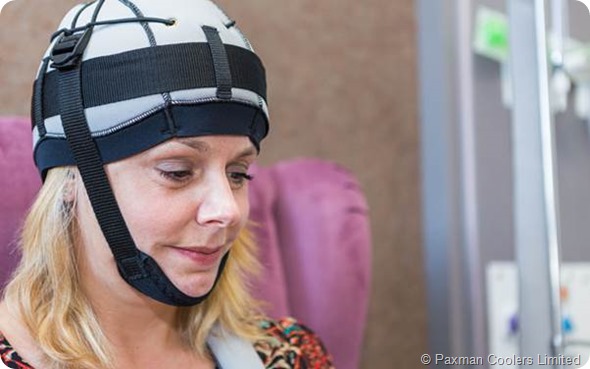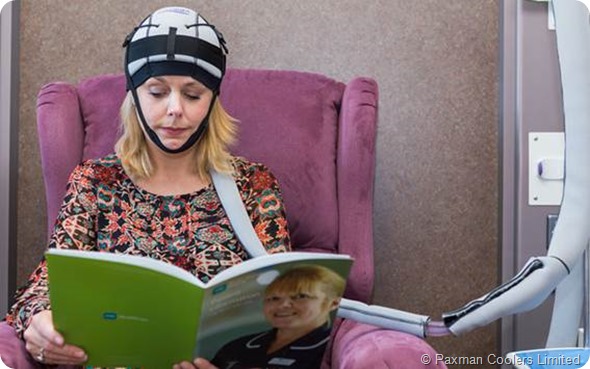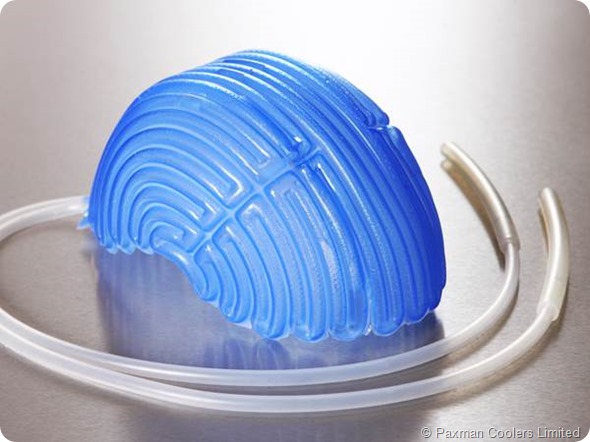Sponsored Content by PaxmanApr 19 2016
Why does hair loss occur during chemotherapy?
The basic principle of chemotherapy is to damage the mitotic and metabolic processes in the cancer cells.
The chemotherapy doesn't just target the cancer cells, it also targets the healthy cells, specifically ones that are rapidly dividing - our hair follicles are also rapidly dividing.
We see damage to those hair cells, which then causes the hair to fall out.
Does hair loss occur in every cancer patient having chemotherapy or only some?
It doesn't occur in all chemotherapies, but, generally, with taxanes and anthracycline-based therapies, you will see complete hair loss. It happens quite rapidly. After the first cycle, you start to see rapid hair loss.
Paxman: Pioneers in Scalp Cooling
Paxman: Pioneers in Scalp Cooling from Paxman Coolers on Vimeo.
How does hair loss affect chemotherapy patients?
I think it is very much to do with quality of life. We see patients with hair loss or chemotherapy-induced alopecia having greater levels of depression and stress.
We see a loss of self-esteem or what we would call a poor self-image. Patients have always got that visible sign of the cancer, meaning every time they look in a mirror, the fact that they are unwell is reinforced.
In terms of my own experience, I was a 10-year-old boy when it happened to my mum. The parent looks different and the relationship can be altered. It can also be altered between husband and wife. It greatly affects a patient.
I think another important thing is that a lot of people often think it could be vanity and it is certainly not. We have seen that depression and stress can actually cause negative clinical results. If a patient has a weakened immune system due to depression and stress, this often means they don’t get as well as they should do.
We've also seen that 1 in 12 or 8% of patients actually refuse chemotherapy because of hair loss. If we can stop that patient population from not going ahead with the chemo and make sure they do have the right drugs, then that alone has a massive impact on patient outcome.

What is scalp cooling and how was the technology developed?
Scalp cooling has been around for about 50 years, originally a mixture of crushed ice and tourniquets were used. The tourniquet was used to restrict blood flow and the crushed ice was used to cause vasoconstriction and other factors.
Over the years, this has developed and more comfortable gel packs have been used, a bit like the sports injury packs that are wrapped around a patient's head.
Back in the early '90s, my mum was offered some type of scalp cooling treatment, but unfortunately it wasn't effective. Starting to lose her hair was the first visible sign she was ill and that was the first time she actually cried.
My sister cut her hair off for her, which is a big deal when you're young. It was the first time she looked like she was dying, which had a really big impact.
My dad started to look at why the scalp cooling hadn’t worked. He started to think about what we could do, having had a long history of refrigeration (about 50 years) in our family.
Specifically, the experience of refrigeration was in drinks dispense and beer cooling, which is quite diverse from what we're doing now. However, it gave my dad and his brother who was also involved in the refrigeration side of things, the idea of trying to develop something that will work for patients in the future. Of course, it was not going to work for my mum – it was too late – but they wanted to do something to help others.
The principles behind scalp cooling are cooling the scalp to around 18˚C. We induce vasoconstriction and restrict the amount of blood flow to the hair follicles during chemotherapy. You also see a drop in metabolic rates, so cell division is reduced. You see less drug diffused through the cell membrane, meaning the chemotherapy is less targeted to the hair cells. All these factors combined make the chemotherapy less effective locally on the hair follicles, so it doesn't damage them.

What further improvements to the technology are in the pipeline?
We launched our first system back in 1997. Since then, we have developed two further systems. We are now on our third generation of equipment and soon to launch our fourth generation. We're constantly evolving how the equipment works.
What's been very important is that there's a lot of interaction with the clinicians, nurses and also with patients, meaning we get a real understanding of what they want. Usability and simplicity is key for us. As well as improving the efficiency of the equipment, we have also improved the usability, which is really key when working with hospital systems. This is an additional therapy, so we've got to make sure it's easy to use and manageable by the clinic.
I would say our latest biggest development is a new cap. We've been working closely with the Huddersfield University, developing a cap which is suitable for head shapes and sizes throughout the world.
One of our biggest problems is how well the cap fits on the patient's head. The cap is worn for 30 minutes before chemo, during chemo, and 90 minutes afterwards. What's really important is that it molds to the head shape and enables good contact throughout the scalp. That's very difficult, especially as our business has grown and we have started to do more and more international work. One of the biggest problems we saw was in Japan, where the cap really didn't fit well to the head.
Will you be bringing out different caps for different head shapes?
We've tried to develop a cap which suits many shapes and head sizes. It's not quite a one-size-fits-all, but it will hopefully be three-sizes-fits-all. We'll continue to improve that. We've got an ongoing knowledge transfer partnership with the University looking at improving it further.
What's very important to me is personalization. Personalized caps is the way forward and I think we can achieve that by using the different technologies that we've been exposed to over the last two or three years.

Can you please outline Paxman’s goal to ‘chase zero hair loss during chemotherapy’? Over what time period do you hope this will be achieved?
In one of our other collaborations with the University, we’ve been looking at cell biology; looking at our own in vitro cell culture models to see how the chemotherapy is affecting the hair cells, what different mechanisms there are and what different mechanisms are engaged when we actually cool. If we can understand more about why it's happening, then we can find ways of improving the results.
We had a two-year knowledge transfer partnership, which gave us some invaluable information about what is happening on a basic biological level. What we're doing now is taking that further. We are working with a number of doctors from the University along with our PhD student we're sponsoring, to look at what we can do to improve those results.
For example, at the moment, across a wide range of chemotherapy regimens, we see around half of patients keeping their hair. Now, with some regimens it's better, while, with others it's worse, but on average, 50% is a fair expectation.
By 2020, we believe we can improve that to 80% with the investment we're putting into the product, the science and the international clinical trials that we're working on. We have a vast network of people we work with, ranging from dermatologists and biologists, through to oncologists and surgeons, all of whom are looking to find the solution. We strongly believe that with the right resource, we'll do it.
Do you think it'll ever be 100%?
I'd love to say it could be 100%, but we've tried to set something we believe we can reach. Our marketing material actually says: "Chasing zero hair loss." That is in the future.
Perhaps one day there will be treatments that won't cause hair loss at all and we'll all be happy – our work will be done and the patients' quality of life will have improved. That's what we're doing at the moment.
Paxman was recently awarded the ‘Partnership with Academia Award’ at the Medilink Yorkshire and Humber Healthcare Business Awards. Can you please outline the two-year project with the University of Huddersfield the prize was awarded for?
We've probably been working with the University now for four years. It originally started looking at some very basic science. It relates back to what I was saying earlier about trying to understand more about the mechanisms. What we found was that these innovation vouchers wouldn't allow us to take it much further, but it was a proof of concept. That was the initial stage.
Then we won an Innovate UK Smart Award, which allowed us to work with the University on both the biology and design. A large proportion of the funding went to the basic science and a large proportion actually went to product design and developing the new cap that I was talking about earlier.
Have you reduced scalp cooling treatment times?
We're still looking at that. We're working with a Dutch scalp cooling research group who have been doing some randomized studies looking at what the optimum scalp cooling times are for certain drugs. With certain drugs, we've been able to reduce times from, at one point, 150 minutes to 90 minutes, then from 90 minutes to 45 minutes and now from 45 minutes to 20 minutes.
That won't work for all chemotherapy regimens, but the key is to try and identify those that it does work for, because the less time the patient's in the hospital, the happier the patient is, the happier the hospital is and the less barriers there are to offering scalp cooling.
We're also looking at other drugs to see if it's a possibility and to see what level of variants there are. In terms of understanding the mechanism, we believe we will be able to find other ways of improving efficacy, while reducing scalp cooling times.
What do you think the future holds for reducing hair loss during chemotherapy and how do Paxman plan to contribute?
I think it really relates back to the work we're doing. We're investing heavily in clinical trials in a number of different countries, including Japan, America, Australia, and the UK. The more research we do and look at different variables, the more we can understand about chemotherapy-induced hair loss and the more ways we can actually find to improve it. I think we will be at the forefront of any improvement in reducing chemotherapy-induced hair loss.
We're hoping for FDA approval in the U.S. this year. We don't have FDA approval, but we've got an ongoing multi-center clinical study throughout the US which we expect to close very soon and then FDA clearance will follow by the end of 2016.
Could there be any additional applications of scalp cooling other than for chemotherapy patients?
Not other hair loss, unfortunately, but the research that we are doing could lead to breakthroughs in other areas. Cooling has many different applications and we are in initial talks, looking at different potential cooling treatments.
Where can readers find more information about scalp cooling?
There are lots of resources, but most of the information is available on our website. They can also contact us. We're more than happy to speak to patients by telephone or e-mail.
About Richard Paxman
Richard Paxman is CEO of Paxman Coolers Limited, an innovative Huddersfield-based family business that’s helping improve the lives of cancer patients throughout the world who are undergoing chemotherapy.
Paxman produce a scalp cooling device that helps prevent hair loss - a distressing side effect of chemotherapy. The Paxman family’s experience in cooling technology for the drinks industry, combined with a family member’s diagnosis with cancer and subsequent traumatic hair loss during chemotherapy, were the inspiration for the development of the product.
Richard studied management science at Manchester’s UMIST and joined Paxman Coolers in 2008. Since then the business has had international success and scalp cooling has become a common treatment practice in oncology and treatment centers for all cancer chemotherapy patients globally. It is his vision to ensure that every applicable cancer patient, no matter where in the World, has the opportunity to maintain their dignity and normality by keeping their hair.
More information about Paxman:
Scalp cooling provides the only real alternative to hair loss resulting in a high level of retention or complete hair preservation, improving patients’ self-confidence and creating positive attitudes towards treatment. The scalp cooling method works by lowering scalp temperature before, during and after the administration of chemotherapy. Paxman is working globally with clinicians and patients to achieve ‘zero hair loss’ and are doing everything possible to understand alopecia and improve scalp cooling for the hundreds of people who use it every day.
How it all began
In 1992 Sue Paxman was diagnosed with breast cancer. During her fight with cancer, Sue lost her hair, an incredibly traumatic experience for her and the whole family. During this time her husband Glenn was determined to find a way to help her retain their hair and through the family business, he and his brother Neil developed the first Paxman scalp cooler. Sue sadly passed away in 2000 but her legacy lives on through the development of the Paxman Scalp Cooling System, which today is the world’s leading hair loss prevention system for chemotherapy patients, used by over 100,000 patients in 32 countries.